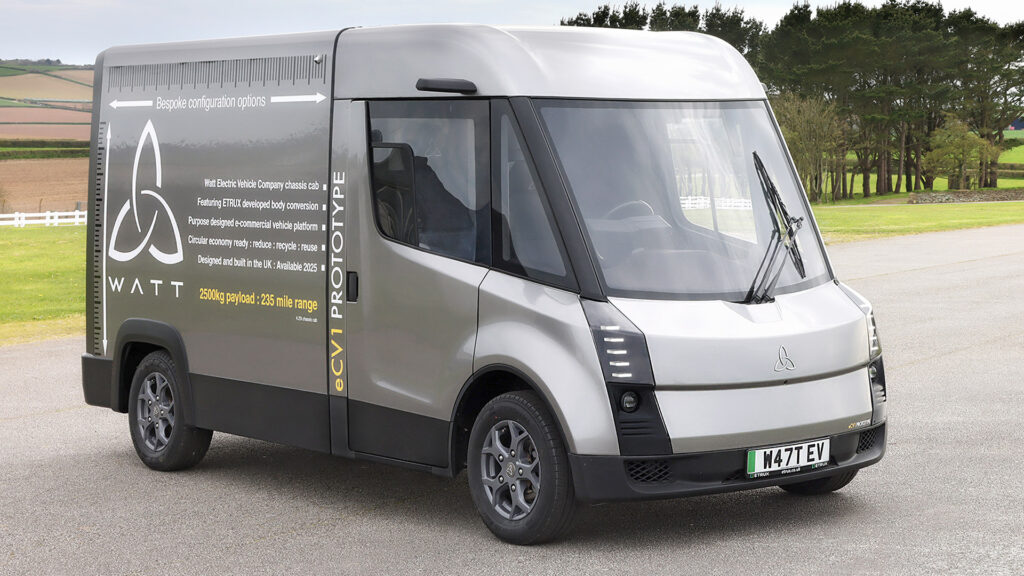Watt Electric Vehicle Company (WEVC) is set to launch the first of multiple commercial vehicles at the Innovation and Technology in Transport (ITT Hub) show at Farnborough airport on 10th-11th May. The eCV1 will be built using Reduce-Recycle-Reuse principals and should offer commercial customers a 235 mile range with a payload up to 2,500kg. WEVC already develops niche EV passenger, sportscar and light commercial vehicles, with production facilities in Cornwall and the Midlands in the UK. This new model aims to be in production by 2025.
The eCV1 is a 3.5t electric light commercial vehicle that has already started intensive real-world testing as development continues in parallel. The innovative and highly flexible vehicle enables a wide range of electric commercial vehicle designs, facilitating mission-specific models that meet customers’ particular fleet requirements. Designed for production of up to 5,000 vehicles per annum, the WATT eCV1 features WEVC’s breakthrough, proprietary PACES architecture, a sophisticated yet cost-effective modular electric vehicle platform.
Neil Yates, CEO of WEVC, said: “We had an amazing debut of the eCV1 prototype at the CV Show, with media and potential customers alike, clamouring to see our new vehicle. The response was really humbling after thousands of hours of work to get to this stage, but the biggest surprise for people at the show was that the show vehicle is fully functional and that we had driven it onto the stand. Since the NEC debut, we have been out testing the vehicle in the real world to continue developing the vehicle for production.”
The eCV1 has WEVC’s innovative, flexible architecture, which enables cost-effective production of mission-specific electric light commercial vehicles below 5,000 units per annum. This architecture is optimised to minimise weight, promising to deliver class-leading payload and reduced energy consumption with lower running costs.
WEVC’s PACES architecture has a ‘cell-to-chassis’ system, which means batteries are integrated into the primary structure rather than having a separate battery pack. This optimises stiffness, minimises weight, and maximises payload. The eCV1 is a clean-sheet design, so it has none of the structural, weight, and packaging compromises inherent in most electric LCV designs, many of which have been converted from ICE drivetrains and are further constrained by traditional high volume manufacturing processes.
The eCV1 features a central driving position which allows a safer kerbside exit for the operator, whichever side of the road the vehicle is driving or parked on. The cabin can be configured as a one-, two- or three-seater vehicle, with the large glass house providing superb visibility, making the vehicle safer to drive and easier to manoeuvre and park. The central driving position also allows the A-pillars to be repositioned inboard, thus reducing frontal area and drag, a key metric in designing an efficient electric commercial vehicle. The unique platform design creates generous full-standing-height headroom, facilitating easy ingress and egress and a ‘walk through cabin’ option that is ideally suited for urban delivery vehicles.
The eCV1 prototype has a kerb weight from just 1750kg, delivering class-leading payload and range in the 3.5t and 4.25t segments. The CV Show was the first chance to see the functional prototype, which continued test and development activities directly after the event. The vehicle is expected to be a game-changer, offering a unique solution to surging demand for bespoke e-commercial vehicles, allowing fleet operators and specialist vehicle converters to make the transition quickly and cost-effectively.
Following the signing of a memorandum of understanding (MoU) between WEVC and electric commercial vehicle specialist ETRUX earlier this year, the engineering prototype will be on display at Farnborough 10th and 11th May 2023.
